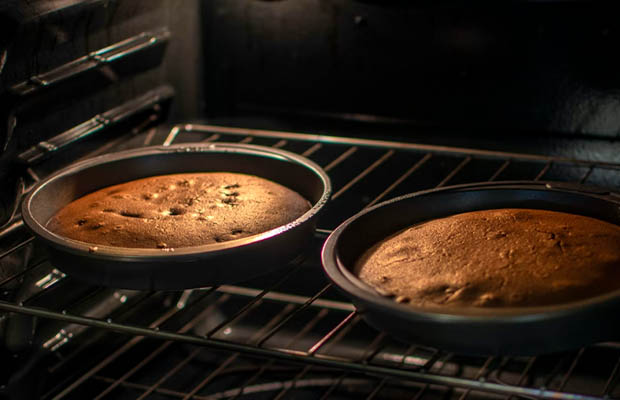One of the best cookware materials and a favorite of chefs worldwide are stainless steel. If used and maintained properly, it is incredibly durable and can last for many years.
Additionally, due to its extreme versatility, it can be used for a wide range of cooking methods without suffering any harm. Though what about baking? One frequently asked question is can stainless steel go in the oven?
Generally, ovens are safe for using stainless steel frying pans. Generally speaking, depending on the brand and model, stainless steel frying pans can withstand temperatures between 500 and 600 degrees Fahrenheit.
Furthermore, I have covered all of the advantages, restrictions, and risks associated with using stainless steel in the oven in this comprehensive guide.
Table of Contents
Is Stainless Steel Oven-safe?
Stainless steel is a metal-alloy containing chromium, silicon, nickel, and manganese, with some elements of carbon and nitrogen.
Depending on the manufacturer and the caliber of the finished product, different amounts of these components are used.
Stainless steel is generally oven-safe; however, to avoid any mishaps such as the pot or pan breaking, splitting, or melting, you must choose the best-grade stainless steel and use suitable oven temperatures.
The handles on some stainless steel cookware can be made of silicone, plastic, or wood as well. It is unsafe to put this in the oven, even though it might improve its aesthetic appeal and make it easier to touch when it’s hot.

If you want to use your stainless-steel pans and pots in the oven, it is best to get ones without wooden or plastic handles since the high heat of the oven will burn and damage them.
While wooden and plastic handles are a complete no-go, baking silicone is oven-safe at temperatures up to 428°F.
Therefore, even though you can bake with silicone in stainless steel cookware in the oven, you must be careful not to raise the temperature too high.
The best stainless steel is very strong and resistant to rust and corrosion. It contains the ideal combination of elements to deliver good tensile strength while preventing leaching and transfer into your food.
Chromium content in quality stainless steel ranges from 18% to 20%, with a higher level indicating greater corrosion resistance. According to US standards, stainless steel used for cooking needs to have at least 16% chromium.
The acceptable range for nickel is between 8% and 10% because anything less will make it more prone to rusting and anything more will make it leach into your food.
Based on the composition of the alloy and slightly different characteristics, stainless steel comes in a variety of grades. Grade 304 stainless steel is the best quality for cookware due to its incredible corrosion resistance and value.
Read More: Why Do They Call It Oven?
Advantages Of Using Stainless Steel In The Oven
A mainstay in both residential and commercial kitchens, stainless steel cookware has been around for a while. They are frequently preferred when it comes to kitchen cookware, and with good reason.
In comparison to other cookware materials, these are the top benefits of using stainless steel in the oven!
Long-lasting
Stainless steel cookware can last for decades, or more if used and maintained properly. Put an end to the possibility of it being damaged by minor kitchen mishaps like scratching or chipping.
High-quality stainless steel is resistant to rust and corrosion and can withstand normal wear and tear.
Even Cooking
Multi-ply stainless steel cookware is a fantastic option for use in the oven because of its quick heat absorption and even heat distribution.
The layers of stainless steel and aluminum produce a more homogenous cooking surface that will heat up evenly from the bottom and sides of the pan.
Naturally Non-reactive
Compared to other cookware materials such as aluminum, copper, cast iron, and Teflon, stainless steel is naturally non-reactive and will not interfere with the chemical structure of your food.
Anything can be baked without fear of releasing any hazardous chemicals or imparting a metallic flavor.
Low-maintenance
Stainless steel is extremely low maintenance and easy to clean.
You can easily soak the pan in the sink (which you could never do with cast iron) and scrub it clean with mild soap if you have a baking accident and have burnt food residue stuck to the bottom of the pan.
For difficult messes, you can also use specialized cleaners and polishes.
Disadvantages Of Using Stainless Steel In Oven
There are several advantages to using a stainless steel bowl or pan in the oven, but you should be aware of some restrictions as well. These include:
Food May Stick
Food sticking to your bakeware and equipment is a major issue whenever you’re baking anything with any kind of utensil, unless it has a nonstick surface. As stainless steel is not nonstick cookware, it seems to exacerbate the problem. You must therefore make sure that everything is ready in this situation.
Try to follow good non-stick procedures, such as using parchment paper and lubricating the utensil with butter or oil., to prevent the food from sticking.
Discoloration Issues
Keep in mind that stainless steel is reactive-free and has a high melting point. But even so, discoloration could happen if you subject stainless steel to extremely high heat. Now, unless you want to maintain the overall aesthetics, this won’t be a big problem.
How To Use Stainless Steel In The Oven?
As you can see, stainless steel has an extremely high melting point compared to other materials, like plastic (between 320 and 410 degrees Fahrenheit). However, there are still a few additional factors to take into account before using your stainless steel cookware in the oven.
After all, you wouldn’t want to have a cooking disaster. Or, even worse, your dish may contain toxic chemicals. Following these guidelines will help you avoid that:
Tip 1: Check The Handle
Even though stainless steel has a great melting point, some components of your cookware might not. For instance, the handles on most stainless steel cookware present issues.
A wooden or plastic handle may be included on the majority of stainless steel cookware. As a result, as we already saw, both plastic and wood have a low melting point. Therefore, if you keep your stainless steel pan with a plastic or wood handle, it could end up melting and ruining not only the pricey cookware but also your dish.
Thus, before popping your stainless steel mixing bowl or dutch oven into the oven, always check if the handle is oven-safe, too, or not.
Note: If the temperature of the oven is kept below 350 degrees Fahrenheit, you can use stainless steel with a plastic handle. Similarly, keep the temperature for a silicone handle below 400 degrees Fahrenheit.
Tip 2: Take Care Of The Quality
The quality of stainless steel is something else you need to watch out for. Notice how much of a difference its metal composition makes in this situation.
Consequently, there are two qualities you should seek out whenever you purchase a new stainless steel bowl:
Stainless Steel Grade
The stainless steel grade talks about its durability, temperature resistance, and quality, too. There are various grades of stainless steel, as mentioned above in the table. Not all, though, are designed for the oven.
For instance, grades 304 and 430 have high melting points and are perfect for oven cooking. Grade 316, on the other hand, won’t be nearly as good because its melting point is a little lower than that of the other grades.
Furthermore, when compared to 316, stainless steel grades 304 and 430 are both less expensive. Consequently, that’s another major plus.
Stainless Steel Quality
Even though the stainless steel grade discusses the general quality, it is insufficient to evaluate the quality or type of metals used in the cookware. Therefore, you need to be cautious if you purchase a stainless steel pan from an arbitrary vendor.
Fortunately, there are a few ways to determine whether your stainless steel pan is of high quality or not.
Avoid using your low-quality stainless steel cookware in the oven. Heat can cause cheap and toxic materials to leak into your food.
Tip 3: Wrap A Kitchen Towel Around The Handle
Stainless steel pans with metal or steel handles are frequently used by bakers and chefs. The reason is that sometimes the cookware will be extremely hot when you remove it from the oven. So this method might be useful to prevent burns.
Simply wrap the handles of the cookware in a thick, heat-resistant kitchen towel, and keep it inside the oven. Simply hold the handle that has been wrapped in a towel when using it to ensure safety.
Tip 4: Don’t Go Above 500 Degrees Fahrenheit
Even though stainless steel can withstand temperatures well above 500 degrees Fahrenheit, it’s best to avoid doing so.
Otherwise, a stainless steel pan might start dispersing heat unevenly if you subject it to extremely high temperatures.
Tip 5: Keep An Eye On The Oven
It should go without saying, but if you just purchased new stainless steel cookware, keep an eye on it while it’s inside the oven.
If you overheat something that is unintentional of low quality, it might become damaged. So, if it’s your first time using a stainless steel pan in the oven, try to pay close attention.
How Does Putting A Pan In The Oven Affect The Results?
Whether or not your pan can go in the oven will determine the answer.
There is a good chance that your frying pan will get damaged and your food won’t turn out edible if you use an oven-incompatible frying pan. Melted coatings or handles represent the most frequent type of damage in this scenario.
The food in an oven-safe frying pan will bake if you place it in the oven. Cast iron or stainless steel are the most common materials for oven-safe pans, and they frequently have bare metal or steel handles. When you remove the pan from the oven, be mindful of the handle’s heat.
When using their frying pans on the stovetop and in the oven, professional chefs wrap kitchen towels around the handles of the pans. Put this technique into practice in your home kitchen by wrapping the handle of a pan that has just come out of the oven with a kitchen towel. You won’t get burned if you do it that way.
How To Clean Burnt Oil Off Of Your Stainless Steel Frying Pan?
It’s also probable that cooking oil or food residue will burn on your frying pan’s surface when you use it in the oven. In order to make your pan spotless once you’re finished cooking, you’ll need to do some additional cleaning.
Here are three quick and effective ways to remove burnt food particles or cooking oil from a stainless steel frying pan right now.
Boil Water And Dish Soap For 5 Minutes
Your frying pan should be filled with tap water and dish soap. The cleaning solution should be heated to a gentle boil on your cooktop. Allow to boil for about five minutes, then let it cool. Try using dish soap and a soft sponge to scrub the burns off of your stainless steel frying pan.
Use Sea Salt
Water should be added to your stainless steel frying pan to cover the burned portions of the cooking surface. Over medium-high heat, bring it to a boil. Add 3 tablespoons of sea salt crystals to the boiling water, let it boil for 1-2 minutes, then turn off the heat.
Allow the pan to cool and soak in the salty water for about two hours. After that, drain the water from your frying pan and scrub the burns and stains away with soapy water and a soft sponge.
Use Baking Soda
Mix one part baking soda with one part water to make a cleaning paste. Apply the paste to the cooking surface where there are burns or stains, and leave it on for about two hours.
After the specified amount of time has passed, manually remove the stains and burns using a soft sponge and soapy water.
Can Stainless Steel Be Used In A Microwave?
The majority of us are already aware that metals and microwaves don’t mix well. What about stainless steel, though? Well, stainless steel is also a type of metal and must not be used in a microwave.
Like other metals, stainless steel reflects microwaves; as a result of this shielding effect, the microwave radiations are blocked and the food cannot be heated properly.
In addition to this reason, there may also be risks associated with using stainless steel cookware in the microwave.
Arcing, which results in sparks and crackles inside the microwave, can happen if the stainless steel comes into contact with the interior walls of the appliance.
This can be a serious fire hazard and can cause the cover on the microwave oven walls to burn down and seriously damage it.
It’s crucial to remember that not every piece of stainless steel cookware can cause a fire in your microwave. It might not result in such negative reactions if it avoids the microwave wall while heating and the reflection surface is sufficiently smooth.
However, there is a chance that using stainless steel in your microwave could harm the appliance, so we advise against taking a chance and never using stainless steel in a microwave.
Can Stainless Steel Be Used In The Dishwasher?
The short answer is: yes, stainless steel is dishwasher-safe and can easily be cleaned in one. The long answer is that there are some risks even though stainless steel is typically regarded as dishwasher-safe.
Many people use the dishwasher to clean their stainless steel pots and pans, and they have no problems. However, occasionally they develop blemishes and watermarks that may be challenging to remove.
Dishwasher detergent is considered to be extremely harsh with continuous use causing spotting and discoloration.
You should only put stainless steel pots and pans in the dishwasher if they specifically say so because they have been verified to be dishwasher-safe.
To avoid any damage, it is best to continue hand-washing and drying other items right away.


